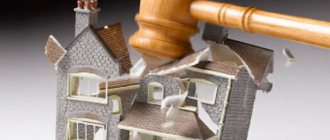Specialists from the Federal Cadastral Chamber explained in detail how to convert a garden house into a residential one. From the point of view of the law, a garden house differs from a residential one in three ways:
- you can live in a residential building all year round, but in a garden building - only during the gardening season;
- You can register in a residential building, but not in a garden building.
- In a residential building, electricity is much cheaper - you can switch to a rural tariff, which you cannot do in a country house.
The latter circumstance makes us think about converting the dacha into a residential building even for those who visit it occasionally.
What kind of house can be considered residential?
The law does not contain the concept of “dacha”.
But the wording “garden house” was introduced. This is recognized as a building that is used for seasonal residence. In accordance with Article 16 of the Housing Code of the Russian Federation, a house, its part or an apartment is recognized as a residential premises. But from January 1, 2021, Federal Law No. 217 dated July 29, 2021, it was recognized that a garden house will be classified as a residential premises if the appropriate transfer is made.
If a citizen registered ownership of a garden house before January 1, 2021, re-registration is not required. The Unified State Register must indicate that the premises are residential.
Reference! If a record is made in the Unified State Register of Real Estate that the building is non-residential, registration will not be possible. It does not matter whether it is located in SNT, intended for farming or individual housing construction.
To clarify the status, an extract from the Unified State Register is required. It can be ordered on the Rosreestr website by paying the state fee.
Take advantage of the “dacha amnesty” in Chelyabinsk.
dacha amnesty program has been extended until March 1, 2026 .
Go to The dacha amnesty program establishes a simplified procedure for the construction and registration of rights in relation to residential buildings, residential buildings, garden houses that are built on dacha and garden land plots provided before August 4, 2018 (before the entry into force of Law 340-FZ “On Amendments to the Town Planning Code of the Russian Federation and certain legislative acts of the Russian Federation"). According to it, you can transfer your country house to residential status without the cost of a technical inspection and without the participation of the local administration.
In order to take advantage of the dacha amnesty in Chelyabinsk you must:
- Prepare a technical plan for the reconstruction of the house; it can be done by a cadastral engineer.
- The finished plan must be submitted to the MFC, from where it will be transferred to the cadastral registration authorities.
Addresses of the MFC in Chelyabinsk:
1. MAU of Chelyabinsk, Chelyabinsk region MFC - Labor
2. MAU branch in Chelyabinsk, Chelyabinsk region MFC - Komarov...
3. branch of MAU Chelyabinsk, Chelyabinsk region MFC - Novoros...
4. branch of MAU Chelyabinsk, Chelyabinsk region MFC - Pobedy
MAU of Chelyabinsk, Chelyabinsk region MFC - Labor
Address: 454091, region. Chelyabinskaya, Chelyabinsk, st. Truda, 164
Website: https://www.mfc74.ru
Phone: +7(351)2110892
MAU branch in Chelyabinsk, Chelyabinsk region MFC - Komarova
Address: 454077, region. Chelyabinskaya, Chelyabinsk, st. Komarova, 39
Website: https://www.mfc74.ru
Phone: +7(351)2110892
UIA branch in Chelyabinsk, Chelyabinsk region MFC - Novorossiysk
Address: 454129, region. Chelyabinskaya, Chelyabinsk, st. Novorossiyskaya, 118V
Website: https://www.mfc74.ru
Phone: +7(351)2110892
UIA branch in Chelyabinsk, Chelyabinsk region MFC - Pobeda
Address: 454000, region. Chelyabinskaya, Chelyabinsk, pr-kt. Pobeda, 396 building 1
Website: https://www.mfc74.ru
Phone: +7(351)2110892
Check the possibility of providing services during a personal visit or by phone.
In a week, you will receive an extract from the Unified State Register of Real Estate (USRN) , according to which your garden house will be designated as residential.
In this case, the house can be in any condition and you will not need to provide a report on its safety.
How to recognize a garden house as residential: requirements and conditions
To recognize a house as residential, it is necessary to check whether it meets the requirements.
The criteria are stated in the Decree of the Government of the Russian Federation No. 47 of January 28, 2006:
- The house must be located in a residential area in accordance with urban zoning or on land plots intended for gardening.
- Load-bearing structures must be reliable, free from damage and deformation.
- The house must be connected to utility systems. It must have water, electricity, heating, and a sewerage system. If the area is gasified, then gas can be installed in the house.
- External structures must be thermally insulated. The property must be protected from water, snow and rain.
- The house must have at least one room and a kitchen.
- The floor level should be higher than the ground level. Residential premises should not be located in basements or on ground floors.
- The house must meet the requirements for noise insulation and electromagnetic radiation.
It is possible to convert a garden house into a residential one only with the consent of all owners.
Reasons for refusal
Such applications are not always approved; there are the following common reasons for refusal:
- The site does not meet legal requirements in terms of size and location.
- It is technically impossible to build a house.
- The dacha does not meet the standards of a residential building.
- There are no title documents.
- The documents have not been verified for authenticity.
Important! Refusal is not always final. This is an opportunity to correct deficiencies and resubmit your application. If you are sure that you are right, you can file a claim in court.
Thus, converting a summer house into a residential building allows you to get additional benefits for living. This makes it possible to obtain permanent or temporary registration. But for this you need to collect documents and perform a certain sequence of actions.
The video story will tell you how the procedure for decorating country houses has changed
Algorithm of actions
The procedure for converting a garden house into a residential one is carried out in accordance with paragraphs 55-63 of Decree of the Government of the Russian Federation No. 47.
The owner must:
- Contact a cadastral engineer to conduct a technical inspection.
- Collect and submit documents to the district administration.
- Get a decision from local governments.
➟ Technical inspection
Before submitting an application, it is necessary to prepare a boundary plan and cadastral passport.
Documents confirm the compliance of the property with the requirements established by law. To obtain papers, you need to invite a cadastral engineer. You can only contact specialists who work in companies registered with the SRO for engineering surveys. The service is paid for by the owner, it will cost 15,000 - 20,000 rubles.
The cadastral engineer carries out all the necessary measurements and prepares a conclusion. Based on it, the owner is issued a cadastral passport and a boundary plan.
➟ Collection and submission of documents
The basis for the procedure is an application from a citizen.
It is drawn up in free form. The document must include:
- applicant's details (full name, residential address, contact phone number);
- cadastral number of the house;
- cadastral number of the land plot;
- a request to transfer the house from garden to residential;
- way to get a solution.
In addition to the application, an extract from the Unified State Register is provided, which reflects the main characteristics of the object and the details of the owners. If ownership has not been registered, then a title document is needed. If there are several owners, the consent of each of them is required. A conclusion issued by a cadastral engineer is also required.
The application and package of documents are sent to local authorities in person or through the MFC, the State Services portal.
➟ Getting a solution
The procedure for reviewing documents is determined by law. The procedure is allotted 45 days from the moment the citizen submits the application. After studying the package of documents, specialists make a decision on recognizing the garden house as residential or refusing to carry out the procedure.
➟ Making changes to Rosreestr
If the decision of the local government is positive, the documents are transferred by the administration to the Rosreestr authorities. The procedure for registering the new status of real estate is underway. The owner must pay a state fee of 200 rubles.
Required package of documents
To re-register land, you will need a significant package of documents:
- Technical plan of the dacha.
- Boundary plan of the site.
- Permission to re-register if the dacha is owned by other persons.
- Legal documents.
- Confirmation from local government authorities on the transfer of land for individual housing construction.
- Redevelopment project, if any.
- Personal statement stating purpose.
- Passport.
These are the main documents required for renewal. But additional documents may be required depending on the specific situation.
Grounds for refusal to convert a country house into a residential one
The applicant may be refused to change the status of the house. This is provided in several cases:
- An incomplete set of documents was submitted to the administration. A refusal will be considered unlawful only in the absence of an extract from the Unified State Register of Real Estate. The specialist must request it from Rosreestr independently.
- Application from a person unauthorized to conduct the procedure. The application can only be submitted by the owner or a representative who has a notarized power of attorney.
- The facility is located on a land plot on which the construction of permanent structures is prohibited.
Attention! Refusal to carry out the procedure must be motivated. A citizen should not have any questions about why he received a negative decision. The document can be appealed in court.
Transfer of non-residential premises to residential premises
The need for such a maneuver may arise under various circumstances. The most common can be considered a real lack of living space, as well as the desire to increase the “payable” area of the property before selling. In both cases, adjacent utility and auxiliary premises or buildings are transferred to the category of living space.
- The premises in question must be completely isolated (separate);
- It must comply with sanitary standards, as well as fire safety requirements;
- The premises must provide for the possibility of redevelopment if this is a prerequisite for living;
- Only the owner or an officially registered representative can deal with issues of re-registration of premises.
How to recognize a house as residential on a summer cottage site in court?
If the applicant is denied the transfer of the house, the decision can be challenged in court.
The application and package of documents are sent to the district or city court at the location of the defendant. The statement of claim must indicate that the refusal is illegal. If the claim is satisfied, the administration will be obliged to reconsider the decision.
Documentation
A set of documents is submitted along with the claim.
| Title of the document | Why are they needed? |
| Administration refusal | A decision made by the administration is provided, which will be the basis for filing a claim. |
| Cadastral passport, boundary plan, conclusion | Documents prepared by a cadastral engineer reflecting the characteristics of the house and plot. |
| Extract from the Unified State Register of Real Estate | To confirm ownership. |
The procedure for converting non-residential premises into residential premises
The transfer of residential premises to non-residential premises is regulated by special laws and regulations and is controlled by authorized bodies. This is necessary in order not only to record the status of real estate objects and keep their correct records, but to comply with sanitary standards and urban planning requirements.
A classic example is shops and offices on the ground floor of a multi-storey residential building. By law, non-residential premises can be located on the first, second and basement floors of residential buildings; there is no such restriction for detached non-residential buildings. So it will not be possible to convert an apartment located, for example, on the tenth floor, into non-residential premises by converting it into an office.
Underwater rocks
In order for the transfer procedure to go smoothly, you need to remember the following important points:
- A cadastral engineer must work for a company that is part of an SRO for engineering surveys. If you contact a specialist who does not have such status, the documents will be considered invalid. The applicant will be denied the procedure.
- If the USRN does not reflect information about ownership, other title documents must be available. Also, all owners must agree to transfer the premises to residential use.
- There may be difficulties with preparing documents. You will need to contact a lawyer who will tell you the list of required papers and help you draw up an application.
The procedure for transferring an outbuilding to commercial use
— specialized stores of chemicals, chemicals and other goods, the operation of which can lead to pollution of the territory and air of residential buildings; stores containing explosive substances and materials; stores selling synthetic carpets, auto parts, tires and automobile oils;
- all enterprises, as well as shops with operating hours after 23:00; consumer service establishments that use flammable substances (except for hairdressers and watch repair shops with a total area of up to 300 sq. m); baths and saunas (except for individual saunas in apartments);
Make an application in 3 minutes through the online service.
Just fill out simple form fields and the service will generate a ready-made application.
Form . . .
The generated document contains not only the entered information.
The statement contains references to laws.
The application also contains legal language that prevents officials from violating the legal rights of the applicant.
As a bonus , the completed application comes with instructions with a step-by-step algorithm of actions.
Second document.
What does this give, why is it needed?
Any owner will enjoy the benefits of converting a garden house to residential status:
- Firstly, official and permanent registration at the location of the house. Hence the difference with garden buildings: you cannot register in them.
- Secondly, property tax deduction . Co-owners have the right to return part of the personal income tax that they paid to the city treasury. You can return 13% only if you register a residential property.
- Thirdly, a 30% discount on electricity payments (rural tariff). The bottom line is that owners of private houses pay less than apartment residents.
- Finally, the opportunity to get a low interest rate on a loan . Yes, banks issue loans for non-residential properties, but the interest rates are much higher and less profitable. A residential building is a potential collateral property.
Having registered a garden object as a residential one, you can move to it from the city on a permanent basis. Now let's see if this is always possible taking into account the requirements for residential buildings?
How can our lawyers help you? Service price
- We handle turnkey business;
- We draw up documents and tell you where you can get them, where to apply and how to proceed;
- We engage a professional expert; our examinations have never been submitted to trial or rejected in court;
- We will prepare an application and collect the entire package of documents;
- We transfer documents to the administration;
- If the administration refused us, then we make full preparations for the trial;
- We protect your interests in court. If necessary, we will appeal an unfair court decision;
- Receipt of a court decision and delivery of a writ of execution to you.
We always work under a contract and immediately explain all the terms of cooperation.
The turnkey service price is 30,000 rubles.
Call now and find out how quickly and most importantly, correctly convert a house into a residential one.
Lawyer's answers to private questions
I want to register individual housing construction on a summer cottage. I learned that it is not included in the territorial zones of the rules that determine the order of use and development. It is not possible to convert a house into a residential one. What should I do?
In this case, you will have to negotiate with the neighboring owners and contact the administration on behalf of the gardening partnership so that, on the basis of the prepared documents, changes are made to the rules of development and land use.
I have a summer house with a kitchen of 8 sq.m. I want to move her to a residential building. Are there any ceiling height requirements?
Yes. The ceiling height must be at least 2.5 m, the kitchen area must be from 6 sq.m.
Is it possible to convert an apartment building into an individual residential building?
Yes, if the number of floors is no more than three (Letter of the Ministry of Economic Development dated March 20, 2013 No. OG-D23-1426). It is necessary to obtain permission for the permitted type of use of the land, as well as for reconstruction, if it is carried out. After this, a technical plan is drawn up by a cadastral engineer, and changes are registered in Rosreestr.
How much does it cost to convert a cottage into a residential building?
Preparation of technical documents costs an average of 20,000 rubles, and the permit is issued free of charge. State duty to Rosreestr – 200 rubles. If a lawyer handles the procedure, it will cost from 30,000 rubles, but the owner will not have to waste his own time.
How to convert a country house into a residential one if it is in shared ownership and the location of the second owner is unknown?
We will have to look for the second owner, or recognize him as missing. Without his knowledge, even the court will not change the status of the property.
Arbitrage practice
Most often, courts refuse to satisfy claims, citing the impossibility of changing the status of buildings due to the fault of the plaintiffs. But situations are different, here are some examples of decisions on real cases:
- On declaring illegal the decision to refuse to recognize a garden house as a residential building (Decision No. 2A-6235/2019 2A-6235/2019~M-5269/2019 M-5269/2019 dated August 29, 2021 in case No. 2A-6235/2019 ). The demands were denied.
- On recognizing a residential building as suitable for living (Decision No. 2-2242/2012 2-2242/2012~M-2511/2012 M-2511/2012 dated December 28, 2012 in case No. 2-2242/2012). The claim was satisfied, and the residential building on the garden plot was declared suitable for permanent residence.
- On challenging the decision to refuse to recognize a garden house as residential (Decision No. 2A-12431/2019 2A-12431/2019~M-8090/2019 M-8090/2019 dated September 4, 2021 in case No. 2A-12431/2019). Satisfaction denied.








